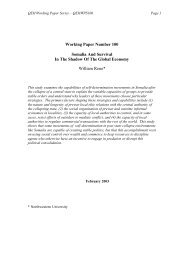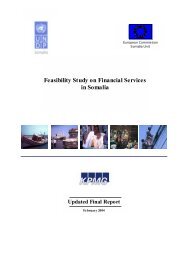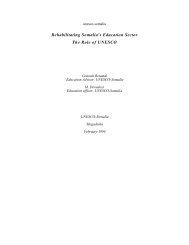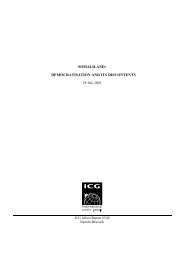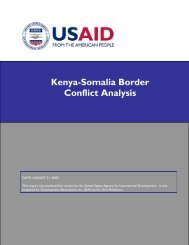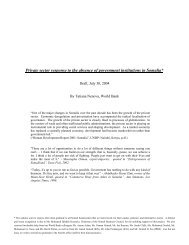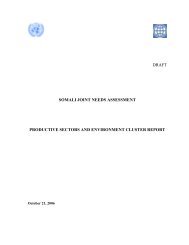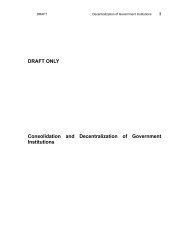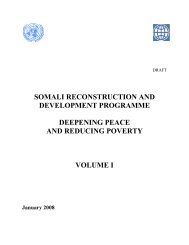Primary Education Survey Evaluation Report Somalia - Somali - JNA
Primary Education Survey Evaluation Report Somalia - Somali - JNA
Primary Education Survey Evaluation Report Somalia - Somali - JNA
Create successful ePaper yourself
Turn your PDF publications into a flip-book with our unique Google optimized e-Paper software.
PES <strong>Evaluation</strong> <strong>Report</strong>, 2008<br />
While it is clear that the survey reports have had very little impact on the MoEs, it is still of major<br />
importance to the various agencies working in the education sector. Staff from Save the Children<br />
indicated that they:<br />
Use data for Base line data, enrolment figures, number of teachers, school environment,<br />
fees of students, community contributions and gender numbers<br />
Data collected targets ministry, but they (the Ministries) don’t use it.<br />
A UNESCO representative supported this position and added that the PES consisted of the only<br />
significant data for the sector.<br />
A wide range of uses of the PES reports were identified by NGOs. These included:<br />
• Data used in proposal preparation.<br />
• Establishing base lines for activities and monitoring progress to assess impact of activities.<br />
• Identifying and prioritising schools in need of water and sanitation support.<br />
• Planning for distribution of supplies.<br />
• Planning for teacher training. (Special focus on women due to very small number of women<br />
teachers identified in the survey)<br />
• Planning for text book production and distribution.<br />
• Use as a sampling frame.<br />
• Prediction of numbers of students progressing to secondary school.<br />
• Comparison of Regions for patterns of enrolment across the country.<br />
• Identifying schools for rehabilitation interventions.<br />
From the above it can be concluded that the PES data is playing an important role in the development of<br />
the sector from an agency perspective. The MoEs seem to be making very limited use of the data at the<br />
present time but have indicated a desire to do so. To facilitate “Evidence Based Planning” there are a<br />
number of issues that need to be addressed, these include timeliness, capacity to use the data, format of<br />
reporting of data, and the development of a systematised and institutionalised planning process. This<br />
institutionalisation needs to take place at central, regional and school/community levels. These issues will<br />
be more fully discussed later in this report.<br />
1.1 Recommendations<br />
a. That timeliness of data reporting be improved to suit institutional needs.<br />
b. That capacity to use the data be developed among stakeholders.<br />
c. That alternative formats of reporting of data be developed to differentiate between stakeholders.<br />
d. That a systematised and institutionalised planning process be developed. This institutionalisation<br />
need to take place at central, regional and school/community levels.<br />
2 EMIS Tools<br />
2.1 Findings and Analysis<br />
This evaluation includes an exploration of the use schools make of a set of tools to assist in managing the<br />
schools. These tools are inappropriately referred to as ‘EMIS tools’ and consist of a Class Register,<br />
School Register, Student record card and a set of detailed instructions on their use. Unfortunately, the<br />
timing of the visit to Zones coincided with school holidays and hence, discussions on their use with<br />
teachers or principals were impossible. Their use was discussed with REOs and Ministry staff. They<br />
estimated that Class registers are used by 80% of schools and school registers by 20% of schools. The<br />
80% may be a bit optimistic since the 2006/7 draft report indicated that only 50% of school had received<br />
the tools. The pupil record cards are very infrequently used, with one REO saying:<br />
They are only used when a student changes schools.<br />
One Zone indicated that these tools were to be a major monitoring focus in the new school year:<br />
24



